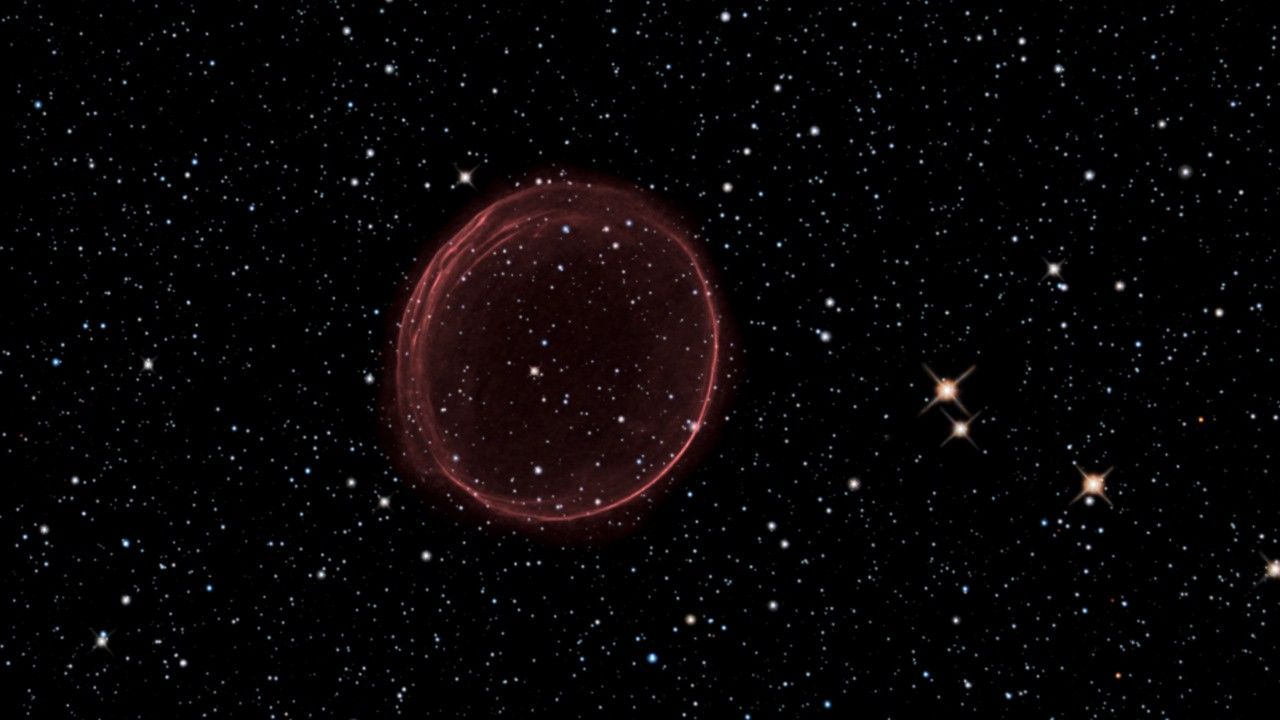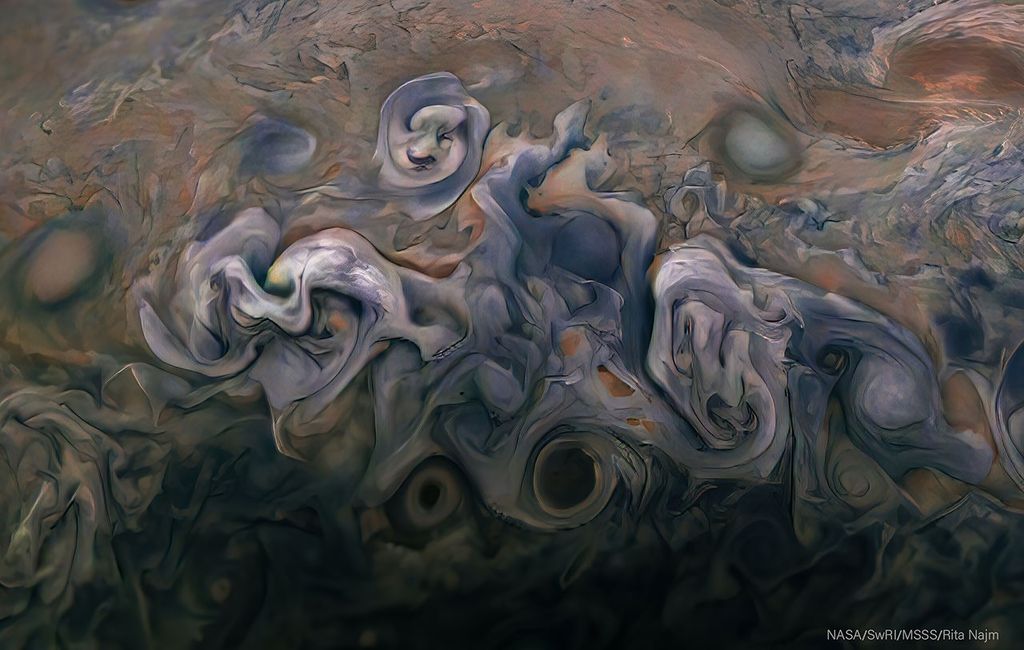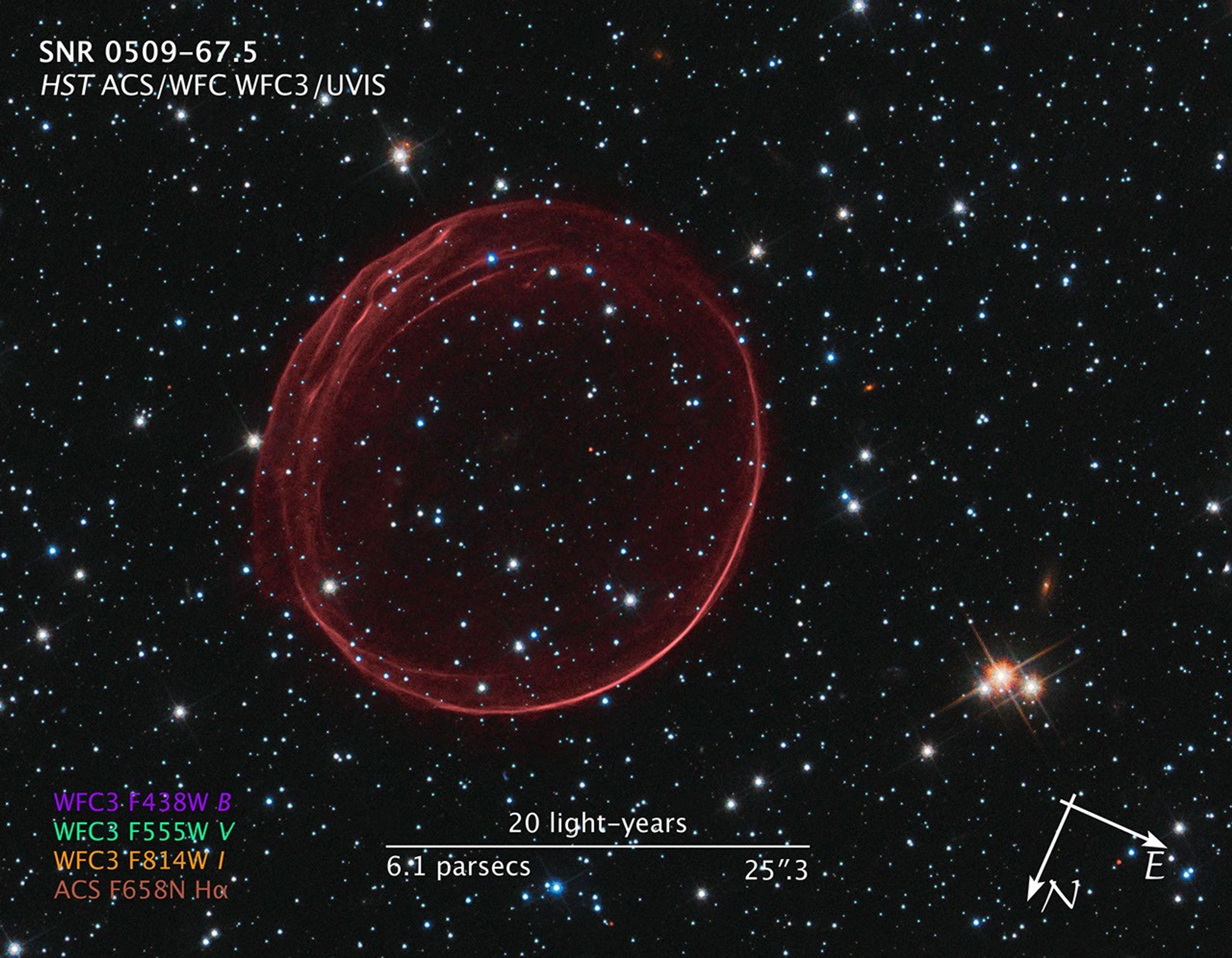1 min read
Hubble Supernova Bubble Resembles Holiday Ornament

A delicate sphere of gas, photographed by NASA's Hubble Space Telescope, floats serenely in the depths of space. The pristine shell, or bubble, is the result of gas that is being shocked by the expanding blast wave from a supernova. Called SNR 0509-67.5 (or SNR 0509 for short), the bubble is the visible remnant of a powerful stellar explosion in the Large Magellanic Cloud (LMC), a small galaxy about 160,000 light-years from Earth.
Ripples in the shell's surface may be caused by either subtle variations in the density of the ambient interstellar gas, or possibly driven from the interior by pieces of the ejecta. The bubble-shaped shroud of gas is 23 light-years across and is expanding at more than 11 million miles per hour (5,000 kilometers per second).
Astronomers have concluded that the explosion was one of an especially energetic and bright variety of supernovae. Known as Type Ia, such supernova events are thought to result from a white dwarf star in a binary system that robs its partner of material, takes on much more mass than it is able to handle, and eventually explodes.
Hubble's Advanced Camera for Surveys observed the supernova remnant on Oct. 28, 2006, with a filter that isolates light from glowing hydrogen seen in the expanding shell. These observations were then combined with visible-light images of the surrounding star field that were imaged with Hubble's Wide Field Camera 3 on Nov. 4, 2010.
With an age of about 400 years as seen from Earth, the supernova might have been visible to southern hemisphere observers around the year 1600. However, there are no known records of a "new star" in the direction of the LMC near that time. A more recent supernova in the LMC, SN 1987A, did catch the eye of Earth viewers and continues to be studied with ground- and space-based telescopes, including Hubble.
About the Object
- R.A. PositionR.A. PositionRight ascension – analogous to longitude – is one component of an object's position.05h 9m 31.69s
- Dec. PositionDec. PositionDeclination – analogous to latitude – is one component of an object's position.-67° 31' 18.0"
- ConstellationConstellationOne of 88 recognized regions of the celestial sphere in which the object appears.Dorado
- DistanceDistanceThe physical distance from Earth to the astronomical object. Distances within our solar system are usually measured in Astronomical Units (AU). Distances between stars are usually measured in light-years. Interstellar distances can also be measured in parsecs.160,000 light-years (50,000 parsecs)
- DimensionsDimensionsThe physical size of the object or the apparent angle it subtends on the sky.This image is 1.2 arcminutes (58 light-years or 18 parsecs) wide.
About the Data
- Data DescriptionData DescriptionProposal: A description of the observations, their scientific justification, and the links to the data available in the science archive.
Science Team: The astronomers who planned the observations and analyzed the data. "PI" refers to the Principal Investigator.The image was created from Hubble data from proposals 11015: J. Hughes, J. Warren, and L. Hovey (Rutgers University), C. Badenes (Weizmann Institute of Science, Israel), C. Smith (NOAO/CTIO), J. Vink (Space Research Organization, Netherlands), and P. Ghavamian (STScI); and 12326: K. Noll, Z. Levay, M. Livio, H. Bond, C. Christian, L. Frattare, M. Mutchler, and T. Borders (Hubble Heritage Team/STScI). - InstrumentInstrumentThe science instrument used to produce the data.HST>WFC3/IR and HST>WFC3/UVIS
- Exposure DatesExposure DatesThe date(s) that the telescope made its observations and the total exposure time.October 28, 2006, and November 4, 2010, Exposure Time: 3.3 hours
- FiltersFiltersThe camera filters that were used in the science observations.F475W (g), F555W (V), F658N (H-alpha+[N II]), and F814W (I)
- Object NameObject NameA name or catalog number that astronomers use to identify an astronomical object.SNR 0509
- Object DescriptionObject DescriptionThe type of astronomical object.Supernova Remnant
- Release DateDecember 14, 2010
- Science ReleaseHubble Supernova Bubble Resembles Holiday Ornament
- CreditNASA, ESA, and the Hubble Heritage Team (STScI/AURA); Acknowledgment: J. Hughes (Rutgers University)

This image is a composite of separate exposures acquired by the WFC3 and ACS instruments on HST. Several filters were used to sample broad and narrow wavelength ranges. The color results from assigning different hues (colors) to each monochromatic (grayscale) image associated with an individual filter. In this case, the assigned colors are: Violet: F475W (g) Green: F555W (V) Orange: F814W (I) Red: F658N (H-alpha+[N II])

Related Images & Videos

Optical/X-ray Composite Image of Supernova Remnant 0509-67.5
This colorful creation was made by combining data from two of NASA's Great Observatories. Optical data of SNR 0509-67.5 and its accompanying star field, taken with the Hubble Space Telescope, are composited with X-ray images from the Chandra X-ray Observatory. The result shows...

3-D Look at a Supernova Remnant
This movie presents a visualization of the supernova remnant known as SNR 0509-67.5. This unique three-dimensional view reminds us that the objects in Hubble images are not all at the same distance but rather spread across light-years of space. The stars and the shell of glowing...
Share
Details
Claire Andreoli
NASA’s Goddard Space Flight Center
Greenbelt, Maryland
claire.andreoli@nasa.gov
































